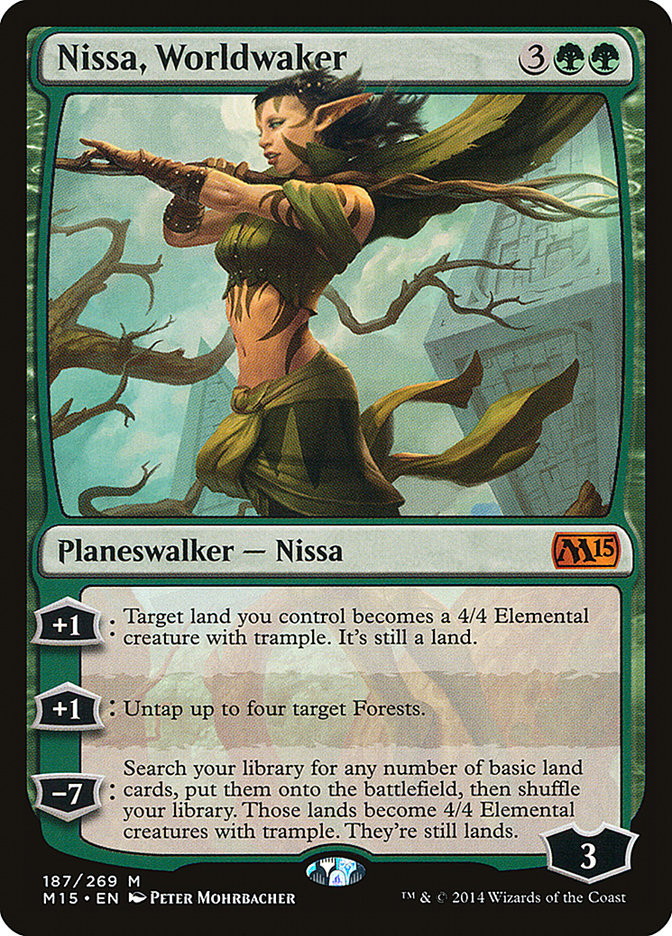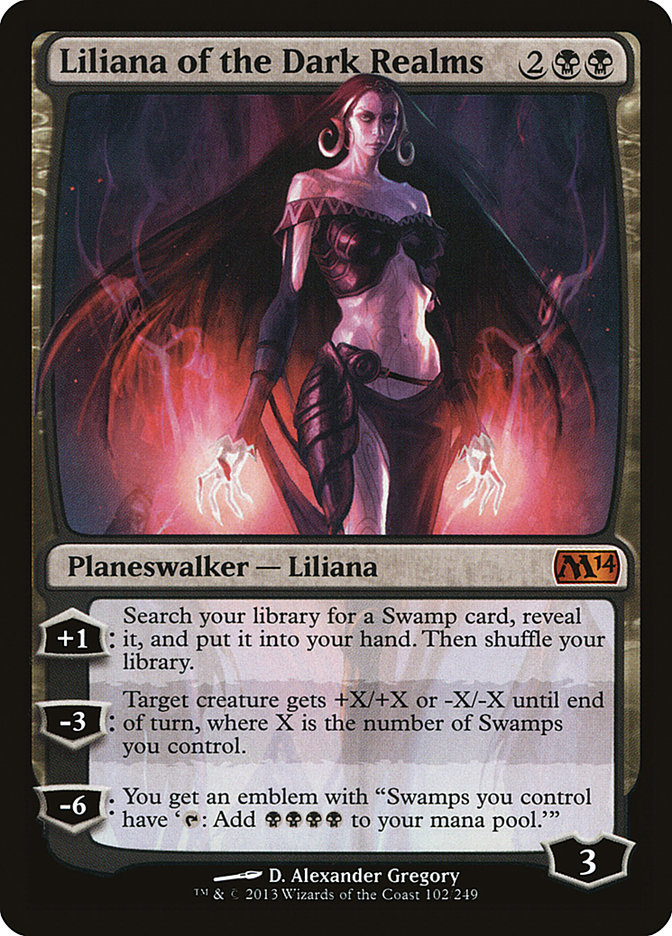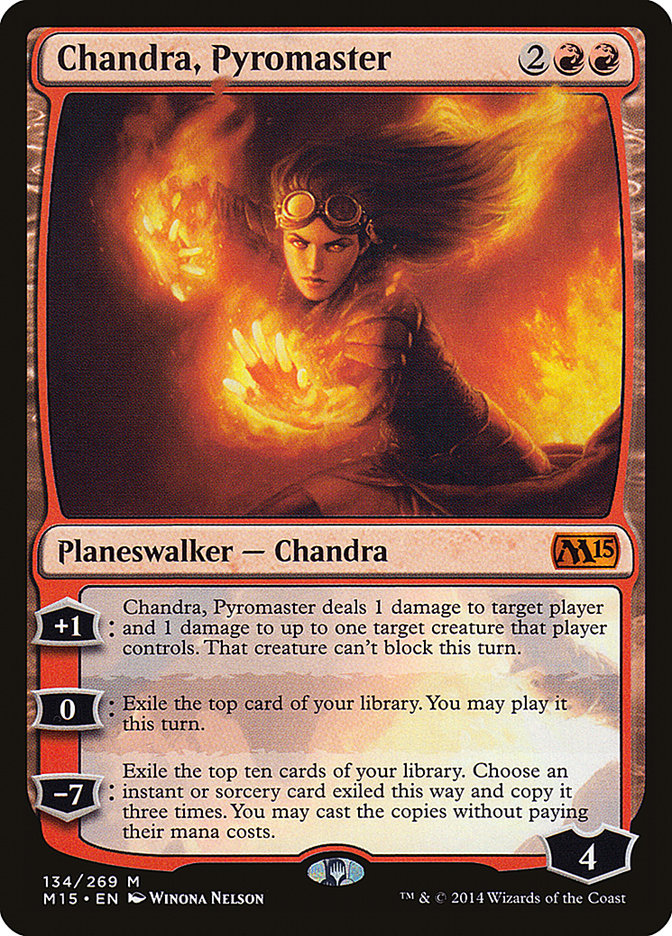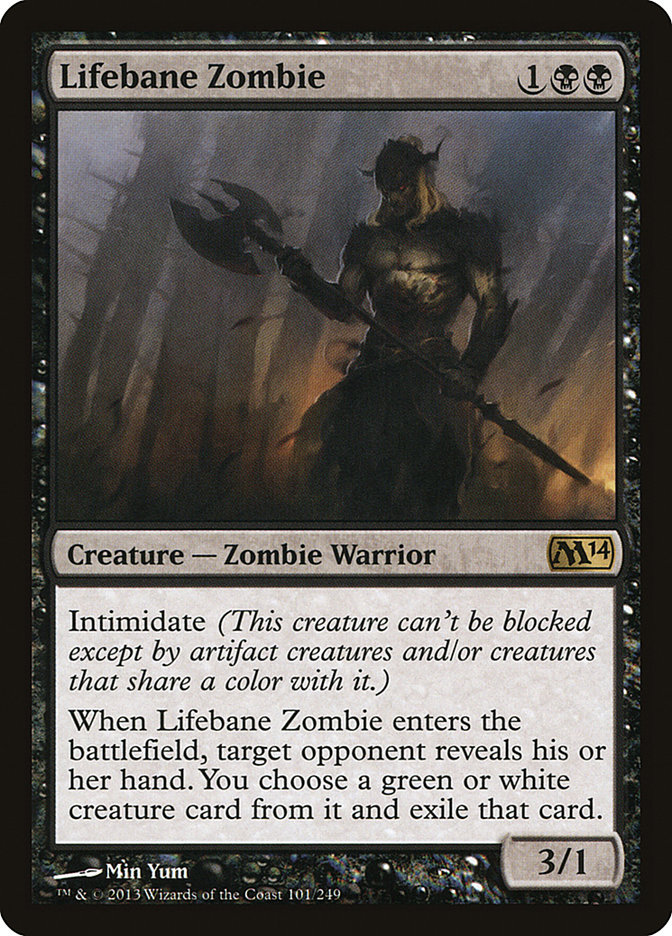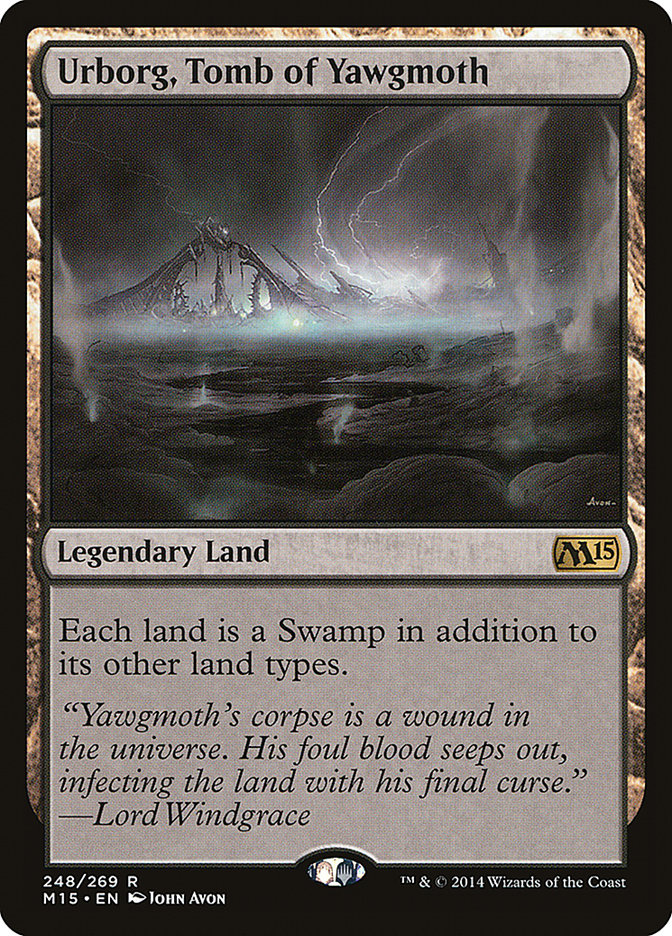The first games I played upon returning to tournament Magic this summer were at the Super IQ in Culpeper, VA, with Jund Monsters. The deck felt powerful
and fun and, after an undefeated run in the swiss, I felt powerful as well. The only reason I moved off of the deck was the desire to try something new.
Well, I’ve since come back to that deck recently for lack of better options and, while the deck is still powerful, the fun has died away. There’s only so
many times you can play Polukranos into Stormbreath Dragon and have it be “fun”.
When I saw Barry Smith’s second place decklist from the Standard Open in Kansas City, I was instantly intrigued. I’ve always loved the thought of sitting
back while my planeswalkers do the dirty work… almost like a Magic version of Heimerdinger and his turrets.
Creatures (8)
Planeswalkers (10)
Lands (24)
Spells (18)
- 1 Putrefy
- 3 Mizzium Mortars
- 1 Dreadbore
- 2 Rakdos's Return
- 3 Abrupt Decay
- 2 Golgari Charm
- 3 Read the Bones
- 3 Hero's Downfall
Sideboard

However, as most have pointed out, Garruk is far too expensive for what he does in this list. That is, he’s simply not taking games over by himself so he
needs the rest of the deck to do a lot of heavy lifting before he ever touches the ground in order to be great. That’s fine in some cases, but for a seven
mana spell, you’d really hope/expect Garruk to be super game changing by himself.
As it stands, he’s good, on the cusp of great, but if he’s not coming down until turn 6 or 7, his ability suite isn’t world-changing. For seven mana, I can
play a Sylvan Primordial and have it make a greater impact in a lot of games.
Then, we had the Pro Tour results come in with multiple versions of the deck placing in the top 8. We’ve all seen the lists at this point, but here they
are again, for reference, as we’ll be doing some in-depth looks at their choices and some other options if we’re going to stick to the Jund shard and the
Planeswalker gameplan.
Creatures (12)
Planeswalkers (11)
Lands (24)
Spells (13)

Creatures (11)
Planeswalkers (9)
Lands (23)
Spells (17)

These two lists have gotten plenty of “air time” recently, but I still want to take a look at some of the differences between the lists and try to
understand some of their choices.
While these lists seem quite similar, I actually noticed a completely different philosophy in these lists. Yes, there are four Nissa, Worldwakers in Yuuki
Ichikawa’s list and that’s a big change in terms of card selection, but it’s also indicative of a completely different gameplan.
Notice how Pierre Mondon has three of each of his planeswalkers of choice, four Read the Bones, and a bunch of removal (in addition to one less Elvish
Mystic). He’s trying to play this deck as a Rock deck of sorts with planeswalkers being used as a way to bury the opponent in a wave of card advantage. He
was making sure he hit plenty of relevant spells by reducing the number of Mystics and playing the full four Read the Bones. This strategy obviously worked
quite well and is definitely one direction we can go when building Jund Planeswalkers.
Ichikawa not only differed in card choice, he also differed in basic philosophy; his planeswalkers are meant to win him the game as actual win conditions,
not just methods to gain an insurmountable card advantage over the course of a few turns. Notice his selection of planeswalkers: he had the full playset of
both Nissa and Xenagos the Reveler, each capable of putting actual threats on the board.
He does include two Chandra, Pyromaster and a Vraska the Unseen as utility ‘walkers, but Yuuki had a plan in mind and he built towards it. Look at the
spell selection: exactly zero copies of Read the Bones. Whereas Pierre wanted to use Read the Bones to continue to push ahead in both card advantage and
card selection, Yuuki simply wanted to stick a threat or two and use his spells to keep his opponent off balance long enough for the stream of 2/2 and 4/4
“haste” creatures to get there.
Basically, it seems as if Yuuki was playing the deck as if it were Jund Monsters without the Monsters. Which, if you think about it…
… was friggin brilliant.
Everyone
knew that Mono-Black Devotion and its variants would be the deck to beat; that meant wave upon wave of Lifebane Zombies taking Polukranos left and right.
You know what big green threat Lifebane Zombie can’t take?
When you step back and view how his list is constructed, it’s really a thing of beauty. Nissa can be used to either press your advantage by untapping lands
or by simply making a big bad threat every single turn.
You can even see this in the sideboards: Yuuki plays the full set of “get ’em dead” Mistcutter Hydras, while Pierre opted for the playset of Magma Sprays
to push back against the “go small” aggro decks. Both had plans in mind and they went for it.
Today, I’m going to look into some possible alternatives that we could look into if we wanted to play this strategy. If you remember, I touched on a Crypt
Ghast list last time that used Liliana of the Dark Realms to great effect. I want to look into the benefit of running the Dark Realms version of Liliana
and see if it’s worth running her over something like, say, Chandra, Pyromaster.
Liliana vs. Chandra
No, there’s not a new Duel Deck coming out for these two, I just want to take a look at why Chandra is starting to see an uptick in play and whether moving
to a Liliana-centric version might be a worthwhile endeavor.
Let’s ponder that, shall we? Why is Chandra seeing so much play in winning decklists all of a sudden? Did people suddenly remember that Chandra exists?
Not really… people have been playing with the card off and on for a while now. Why then is it starting to show back up?
Lifebane Zombie has driven the format to a place where Chandra, Pyromaster is well-positioned. On one level, its popularity has made the Jund Monsters deck
somewhat less viable due to the ability to take away Polukranos and Ghor-Clan Rampager on curve while still putting a clock on the Monsters player. On the
next level, the fact that it’s now such a widely played card, having a threat that’s impervious to its trigger while also being able to take out the Zombie
by ticking up is incredibly beneficial. It’s just a well-positioned midrange card that doesn’t roll over to the terror of green midrange decks right now.
Additionally, against a deck like Mono-Black Devotion that wants to grind you out, having a recurring source of card advantage is also incredibly useful.
Now, people are starting to build around Lifebane though; there are writers who are actively saying that Lifebane is becoming invalidated and that people
should look to possibly playing Nightveil Specter in their Black Devotion lists. If this is the case, this affects Chandra’s positioning in multiple ways.
First, Nightveil Specter is much better against Chandra. Second, if people are moving away from Lifebane, perhaps we should be moving back towards
Polukranos and the like. Also, if we can’t reliably take out a threat with Chandra (i.e, if we’re up against Desecration Demon and Nightveil Specter with a
Chandra in hand, it’s not going to get much done), then is it really worth playing?
That’s where Liliana of the Dark Realms comes in.
Liliana is similar to Chandra, Pyromaster in a lot of ways. Both are four mana planeswalkers who can gain card advantage every turn or be used to remove a
creature. Both can be used as threats as well, though I wouldn’t be too concerned about Chandra’s clock for a long time. Both have ultimates that are “meh”
in that, you’re not really looking to get to either’s ultimate any time soon as it’s not like it’s a game-winning ability in and of itself.
However, let’s look at what Liliana can provide us.
First, she’s guaranteed card advantage at the expense of only being able to get us lands. Swamps, in particular. However, if I have a
three land/Sylvan Caryatid hand, I’m going to be really happy to drop Liliana on turn 3 and go to find that Overgrown Tomb or Blood Crypt. It’s not as
flashy as exiling, say, another planeswalker late game with Chandra and casting it, but that is consistency and deck-thinning.
Next, let’s look at the ability to protect themselves. Chandra can only ping a creature for one, but it does this while ticking up, which is a
major difference from Liliana who can commit seppuku in order to kill something the turn she comes into play. The -3 next to her “kill something” ability
is probably the single biggest reason she’s yet to see as much play as I think she could. If that was a -2, we’d see her all the time methinks.
However, while the downside exists, that doesn’t change the fact that Liliana’s -3 can do things Chandra’s +1 could never dream of doing. Like, oh, I don’t
know… killing Thassa, God of the Sea. Or pumping Mutavault for a lethal attack. Or killing anything with more than one toughness.
“But Michael, we only get to run the eight shocklands and maybe a Swamp or two… how good can that ability really be?”
I don’t think people have realized what this card means for Liliana of the Dark Realms. From synergies with Crypt Ghast to how well it synergized with
Liliana, Urborg did a lot more than simply making Mono-Black Devotion somewhat more consistent. It gave us the ability to play a planeswalkers list that
can do a lot more with their namesake cards than simply churn our attackers or card advantage.
So, with this consistent (and potentially explosive) mana, what can we do?
Two week ago
I gave a list I titled “Garruk Smash.” If we stick to straight B/G, it’s a decent starting point because it gives us the ability to drop Garruk, Apex
Predator while it still has the capability to affect the gamestate in a positive manner.
Creatures (18)
Planeswalkers (6)
Lands (24)
Spells (12)

However, I’m here to discuss Jund Planeswalkers, not B/G.
Let’s look at the “core” of the Jund ‘Walkers Archetype:
2-4 Elvish Mystic
1 Putrefy
That’s 25-27 cards if we’re sticking with Chandra, Pyromaster. Now, let’s look at the effects of moving to a Liliana of the Dark Realms build.
First, we lose the consistency of being able to overload Mizzium Mortars as often as before. That’s not to say that we wouldn’t run the card, but we would
lose the capability of overloading it quite as consistently. However, as long as we keep Mortars in mind when searching with Liliana (getting Blood
Crypts), we can easily mitigate much of this issue.
Past that, it’s a matter of accepting that we’re a base G/B deck with, essentially, a red splash for Xenagos, Dreadbore, Rakdos’s Return, and Mizzium
Mortars. With the added explosive potential we get with Crypt Ghast and the consistency of Liliana, I think it’ll be worth it.
The big question is: are we playing the “card advantage” or “planeswalkers as threats” game? Again, two different strategies completely and we need to
figure out which direction we’re headed. With Liliana not being able to provide a warm body herself, I think we’re priced into the long game a bit if we’re
going into the Dark Realms, meaning we’re looking at going the card advantage/long game route.
So, if we take out the two Chandra, Pyromasters and add in four Liliana of the Dark Realms, that takes us to 27-29 cards. I’ll want to add in two Crypt
Ghasts as well.
Now, what do we have that’ll take advantage of the potential burst mana we can get out of those two cards?
I say we up the Rakdos’s Return count to two in the maindeck and another in the sideboard. Against control, we’re going to have those and a full playset of
Mistcutter Hydras to really push the X mana theme.
Creatures (13)
Planeswalkers (9)
Lands (24)
Spells (14)
- 2 Putrefy
- 3 Mizzium Mortars
- 2 Dreadbore
- 2 Rakdos's Return
- 1 Abrupt Decay
- 1 Golgari Charm
- 2 Read the Bones
- 1 Hero's Downfall
Sideboard

You’ll notice two Slaughter Games in the sideboard; against the winning U/W Control list, Slaughter Games seems incredibly backbreaking. Taking out their
Planar Cleansings when they’ve purposefully left Detention Sphere on the sideline allows our planeswalkers to roam freely while we find our second copy to
take out Sphinx’s Revelation or even Elixir of Immortality if you’re feeling frisky.
There’s not a huge difference in this list from Pierre’s list at the Pro Tour other than a philosophical shift from Chandra to Liliana, a move I think is
smart at the moment. Basically, we let our planeswalkers carry us across the finish line, only this time we stopped the fire and dropped into darker
realms.
How would you build Jund Planeswalkers? Do you prefer the Planeswalkers as threats or the Planeswalkers as card advantage builds? What have your results
been with your builds? Then consider how adding Liliana of the Dark Realms might change that for the better or worse.
I’ll either be playing this for the next couple of weeks. Or something with Young Pyromancer in it…

